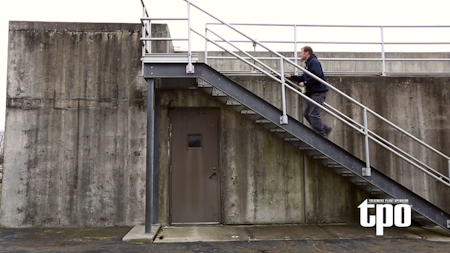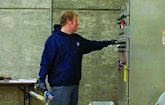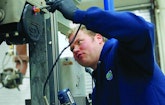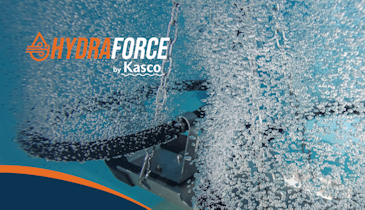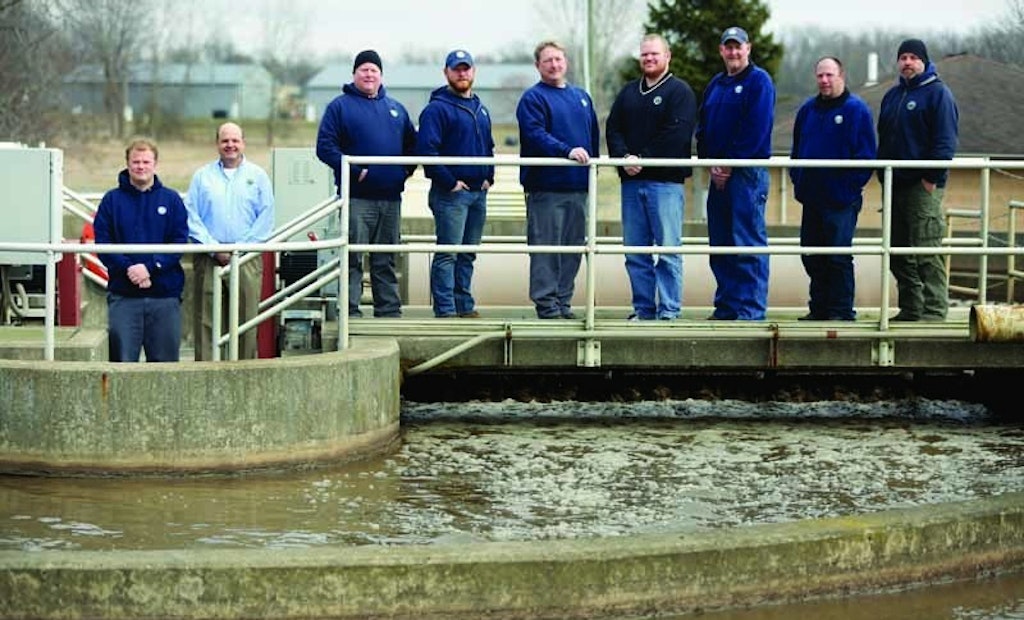
Interested in Pumps?
Get Pumps articles, news and videos right in your inbox! Sign up now.
Pumps + Get AlertsSome might claim that by working in the wastewater industry, Josh Holton isn’t making use of his college degree in political science and education.
Holton begs to differ — he puts his schooling to work on a daily basis. “You have to think more analytically in college courses than you do in high school,” says Holton, lead operator at the Southwest Licking Community Water and Sewer District, based in Hebron, Ohio. “That is what you have to do, day in and day out, at a wastewater treatment plant. It’s all about collecting data, interpreting data and making informed decisions.”
That analytical approach has served Holton well as he progressed from part-time work at a treatment plant during college to his current role and a Class III Wastewater Operator license, the second highest level in Ohio.
It has helped him keep effluent in compliance, hold plant electricity costs down and work within a challenging set of phosphorus-based biosolids land application regulations. It has also helped him earn the 2014 Professional Wastewater Operations (PWO) Award from the Southeast Section Ohio Water Environment Association (OWEA), the 2015 PWO Statewide Award from the OWEA and a 2014 Awesome Operator Award from the OWEA.
Mel Weaver, water reclamation supervisor with the district, observes, “From his very first day here, Josh has displayed the highest level of initiative, commitment, enthusiasm, adaptability and dedication to his craft. He consistently performs at a level way beyond his years of service. I have never seen him display anything other than an extremely positive and motivated attitude toward his work and others.”
Changing course
Holton grew up in Amanda, Ohio, a small community southeast of Columbus. He graduated from high school in 2005 and entered Capital University in Columbus, where he earned his degree. While in college he worked two summers with Fairfield County Utilities, doing odd jobs. “Going into my junior year, I started working part time during school in the wastewater and water departments, operating the belt press and helping out with projects when they needed an extra hand,” he recalls. “I really liked the mixture of indoor and outdoor work. Growing up in the country, I was always outside.”
After graduating from college, he found jobs scarce in his fields. Fairfield County hired him as an operator in training, and he planned to work there until he found a teaching position.
He started working mainly at the largest of the agency’s four treatment plants, a 3 mgd vertical reactor facility. He then became a “floater,” helping out at all four plants as needed. “At that point I decided I might as well get my license,” he says. “I passed my Class I test and realized this was what I wanted to do with my life. I just kind of fell in love with it. I like the freedom of this career. On a given day you can be doing paperwork, pulling a pump, hanging a gutter. It’s very flexible.”
Along the way, the general manager at Fairfield County, Don Rector, P.E., moved to Southwest Licking. In 2012, he hired Holton as an operator. Two years later, Holton earned his Class III license, and he and Weaver hired another Class III operator, Jeff Shaw. Together they now operate the 2.65 mgd (design) Southwest Licking Environmental Control Facility.
Dual trains
The Southwest Licking district commissioned a 1 mgd oxidation ditch plant in 1994, but the community grew rapidly and 10 years later added a 1.65 mgd plug flow extended aeration plant. The facilities operate as separate trains except that solids processing is combined. Effluent discharges to the South Fork of the Licking River. Average flow is 2.1 mgd.
The district’s service area covers about 80 square miles, and the collections system includes 43 pump stations that feed two main influent pump stations, one at the plant site and the other about 2 miles away. “We have 100 percent force main influent stations,” says Holton. “We have no gravity flow into the plant.”
Influent is lifted by two pump stations equipped with submersible pumps (Flygt - a Xylem Brand) and passes through a Parshall flume and a Muffin Monster grinder-auger (JWC Environmental). From there the flow is split. About half goes to the oxidation ditch (Evoqua Water Technologies) and the balance to the extended aeration unit.
“During storm flows or other high flows, the oxidation ditch treats up to about 1.4 mgd, whereas the extended aeration train fluctuates to as high as 6.6 mgd,” Holton says. “Basically, the extended aeration basin provides our storm surge capacity.”
Each treatment train has two secondary clarifiers. Effluent is delivered by screw pumps (Lakeside Equipment) to a vertical-bulb UV disinfection system (Ozonia) before discharge.
Waste activated sludge from both processes at 0.5 percent solids is combined in four 270,000-gallon aerobic digesters. Digested material at 2 percent solids is fed to a belt filter press (Komline-Sanderson) that delivers cake at 14 percent solids.
A covered biosolids bay with a concrete pad has about 250 days’ storage capacity (about 150 dry tons). Contractor Carl Wheeler Inc. takes charge of hauling and surface-applying the material to farm sites; farmers incorporate it into the soil. Holton and his team handle site permitting and specify the application rates.
Facing challenges
Apart from the daily challenges of operating and maintaining an aging facility with a small staff, Holton has had to navigate an increasingly complex set of biosolids rules. Farmers receive the material at no charge. Abundant farmland is available near the plant, though Holton and Shaw look for sites with well-drained soils to minimize times in spring and fall when the land is too wet to accommodate equipment.
Complicating matters significantly, new Ohio EPA regulations took effect in 2013 that require accounting for phosphorus in land application. The regulations aim to help curtail algae blooms in rivers and lakes, most notably Lake Erie. Previously, applications were limited to the amount required to meet the crop’s nitrogen requirement. Now the cap is based on the amount of nitrogen or phosphorus applied — whichever is more limiting based on the soil test. In most cases, the limiting nutrient is phosphorus.
In addition, Holton had to learn how to calculate a Phosphorus Risk Index for each field using Revised Universal Soil Loss Equation Version 2 (RUSLE2) software, a computer model from the Natural Resources Conservation Service that measures the potential severity of erosion from rainfall and runoff.
“Basically it determines the likelihood of particles of soil washing off the field in a rain event and getting to a stream,” says Holton. “It takes into account the soil types, how much biosolids or chemical fertilizer you’re adding, the method of application, local rainfall data, the degree of slope and the slope length of field, and the soil hydrology. It’s very challenging, but it’s definitely for the benefit of the environment.”
Although the South Licking plant has no phosphorus limit for its effluent, Holton believes that may be coming: “It could present some challenges for us operationally.”
Fully compliant
As it stands, the plant maintains an excellent compliance record. Holton and Shaw keep a close eye on the process, drawing extensive data on every process phase collected over several years. Last winter, effluent ammonia began edging upward to 1.0 mg/L, though it remained within the winter permit limit (4.5 mg/L weekly average, 3.0 mg/L monthly average).
“We couldn’t figure out where it was coming from, though we had a couple of indicators,” says Holton. “Because we’ve kept track of everything through the years I’ve been here, we could go back and compare data. There’s DO for every zone, temperatures from every day, all the data in the world that you would want.
“We have four tanks in our extended aeration basin and four sets of diffusers in each tank. By keeping track of our DO readings and comparing them with temperature, we were able to go back and investigate. It immediately struck us that going into the third tank our DO was 0.5 mg/L, when in years past it had been around 1.0 mg/L at the same time of year and at a similar temperature. So it appeared we weren’t delivering quite enough air quickly enough. We made adjustments in our aeration basin to counteract that.”
Active in the industry
Holton keeps sharp not just through diligence in his own facility but also through activity with OWEA; in 2015 he was elected a first-year director of the association’s Southeast Section.
“I think every operator should participate in an organization like OWEA,” he says. “It’s really a great organization because it meshes engineers and operators, and you don’t usually get that interaction in everyday situations.
“It definitely helps you get a feel for all the options available for your everyday tasks. It helps you think outside the box more. At my plant, I don’t get to see all the different technologies out there, or how other people are doing things. OWEA allows that, especially in the section meetings where we do plant tours frequently.”
Looking down the road at his career, Holton aspires to earning his Class IV operator license. He advises other operators to make full use of the resources around them, including the knowledge of experienced operators.
“This industry is going through a major transition where older operators are retiring, and when they do a lot of knowledge will be lost,” he says. “I encourage younger operators to get with older operators and try to absorb as much knowledge as possible before it’s too late. I have benefited greatly from that.”
Power Broker
Living within a budget is always a challenge for a small clean-water utility. Josh Holton and the team at the Southwest Licking Community Water and Sewer District have helped hold down costs by managing electricity wisely. They do it by taking advantage of Ohio’s competitive power market to secure lower costs per kilowatt-hour, and by managing peak demands to keep utility demand charges down.
“We are in the AEP Ohio utility service area, but we actually buy our energy through Direct Energy, a power-based company in Texas,” says Holton. “Because Ohio is a deregulated market, we don’t have to buy power from our local utility.” The Southwest Licking plant’s power is delivered across AEP Ohio lines but is generated elsewhere.
“This arrangement allows us to have much lower per-kilowatt-hour cost than if we purchased it straight through AEP Ohio,” says Holton. “It’s a fairly simple process, and yet in certain ways complex and time-consuming at the same time. My supervisor, Mel Weaver, really started the process, and I have worked with him and helped him.
“It’s definitely something every wastewater utility should look at. Throughout these last few years, our electricity costs have gone up slightly, but without brokering our power the way we’re doing, they would have gone up astronomically. We spend around $200,000 a year on electricity just for the plant. Without brokering we would be spending in the range of $260,000 to $270,000.
“The other aspect is demand management and understanding demand and peak power. We deal with an energy company called EnerNOC for demand response. Our agreement says that anytime the grid is highly stressed, they can direct us to go off the grid by using our backup generators.” In return, EnerNOC sends monthly checks that add up to about $10,000 per year — even though to date the district has not been called upon to fire up its diesel generators (200 kW KOHLER and 800 kW Caterpillar at the wastewater plant, and a 350 kW KOHLER at the water plant).
In working through the demand response program, the Southwest Licking team also learned to manage its own demand. “Under demand charges, the plant’s highest peak of demand in a given month can equate to almost 30 percent of our electric bill,” says Holton. “With the EnerNOC system, we can look at our demand any given time throughout the day. By changing operating procedures, we can cut that demand and keep our costs down.”
The plant normally runs three of its eight 75 hp centrifugal blowers for the aeration basins and aerobic digesters. “During storm flows we have to turn on additional blowers for the increased demand,” says Holton. “But just doing that, even for an hour, costs us about $1,000. So we asked, ‘If we have to turn another blower on, what can we turn off?’ Now, during times of higher demand, if possible, we turn off the aerobic digestion blower.”
